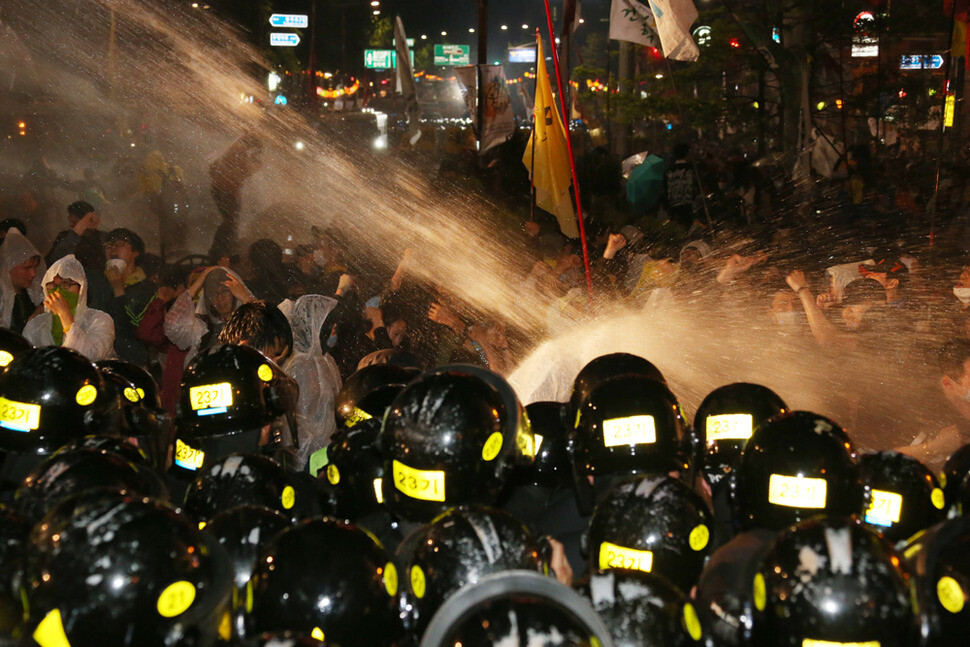hankyoreh
Links to other country sites 다른 나라 사이트 링크
Police stepping up violent crackdowns on protestors

Police are ramping up their tactics against demonstrations over the Sewol ferry sinking. Having already made use of bus barricades, they have now added tear gas (capsaicin) cannons to their arsenal.
Civic groups blasted the police for what they called “excessive use of force.”
A “two-day nationwide overnight action” organized by the April 16 Sewol Network to demand the immediate scrapping of the enforcement decree for the special Sewol Law was launched on the evening of International Workers’ Day on May 1 at Gwanghwamun Square in central Seoul. At around 10 pm, participants attempted a march from Anguk intersection to the Blue House, only to clash with police who had erected a long barricade of buses.
Mobilizing three sprinkler trucks in an attempt to disperse the marchers, police resorted to a water cannon containing a mixture of PAVA, an incapacitant spray using a synthetic form of capsaicin.
“We used a mixture of PAVA diluted to a 0.03% concentration in water, as per internal police guidelines and regulations,” explained Seoul Metropolitan Police Agency first security department chief Yeon Jeong-hun on May 3.
Lee Won-jun, head of security at Jongno Police Station, explained the reason for the use of a tear gas cannon.
“The participants in the demonstration were behaving violently late at night, including destroying police vehicles,” Lee said. “While it is only speculation at this point, we used [the water cannons] because it was possible [the participants] might set fire to Gyeongbok Palace or attempt to enter the Blue House if the police did not stop them.”
The decision on whether to use the tear gas cannons was made by the SMPA chief, and a cannon with a similar concentration of tear gas was used at a demonstration on Apr. 18, the police said.
In response, Amnesty International East Asia researcher Arnold Fang issued an emergency statement on May 2, saying “The clampdown against an overwhelming peaceful protest is totally unjustified, unnecessary and an insult to both the victims of the Sewol ferry tragedy and their families”.
The Korean Federation of Medical Activist Groups for Health Rights, which provided healthcare assistance for the Sewol demonstration, said PAVA “can cause death in cases of overexposure, and may cause blistering and organ damage with repeated exposure.”
Indeed, many participants in the May 1 demonstration complained of difficulty breathing, vomiting, and dizziness.
The two-day action continued until 3 pm on May 2.
“We arrested 42 participants over the two-day period, with one police officer and nine conscripted officers injured and a total of eleven vehicles damaged, including one barricade truck,” police said.
By Park Tae-woo, Kim Kyu-nam and Heo Seung, staff reporters
Please direct questions or comments to [english@hani.co.kr]

Editorial・opinion
![[Column] Park Geun-hye déjà vu in Yoon Suk-yeol [Column] Park Geun-hye déjà vu in Yoon Suk-yeol](https://flexible.img.hani.co.kr/flexible/normal/500/300/imgdb/original/2024/0424/651713945113788.jpg) [Column] Park Geun-hye déjà vu in Yoon Suk-yeol
[Column] Park Geun-hye déjà vu in Yoon Suk-yeol![[Editorial] New weight of N. Korea’s nuclear threats makes dialogue all the more urgent [Editorial] New weight of N. Korea’s nuclear threats makes dialogue all the more urgent](https://flexible.img.hani.co.kr/flexible/normal/500/300/imgdb/original/2024/0424/7317139454662664.jpg) [Editorial] New weight of N. Korea’s nuclear threats makes dialogue all the more urgent
[Editorial] New weight of N. Korea’s nuclear threats makes dialogue all the more urgent- [Guest essay] The real reason Korea’s new right wants to dub Rhee a founding father
- [Column] ‘Choson’: Is it time we start referring to N. Korea in its own terms?
- [Editorial] Japan’s rewriting of history with Korea has gone too far
- [Column] The president’s questionable capacity for dialogue
- [Column] Are chaebol firms just pizza pies for families to divvy up as they please?
- [Column] Has Korea, too, crossed the Rubicon on China?
- [Correspondent’s column] In Japan’s alliance with US, echoes of its past alliances with UK
- [Editorial] Does Yoon think the Korean public is wrong?
Most viewed articles
- 1[Column] Park Geun-hye déjà vu in Yoon Suk-yeol
- 2Thursday to mark start of resignations by senior doctors amid standoff with government
- 3N. Korean hackers breached 10 defense contractors in South for months, police say
- 4[Editorial] New weight of N. Korea’s nuclear threats makes dialogue all the more urgent
- 5Will NewJeans end up collateral damage in internal feud at K-pop juggernaut Hybe?
- 6Kim Jong-un expressed ‘satisfaction’ with nuclear counterstrike drill directed at South
- 7[Editorial] Japan’s rewriting of history with Korea has gone too far
- 8[Column] ‘Choson’: Is it time we start referring to N. Korea in its own terms?
- 9[Cine feature] A new shift in the Korean film investment and distribution market
- 10[Column] The clock is ticking for Korea’s first lady